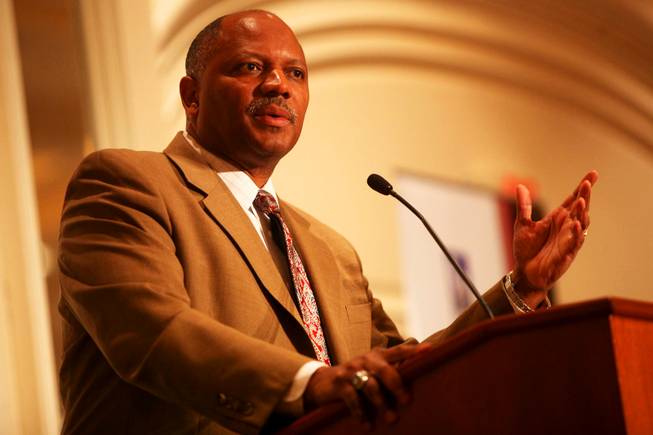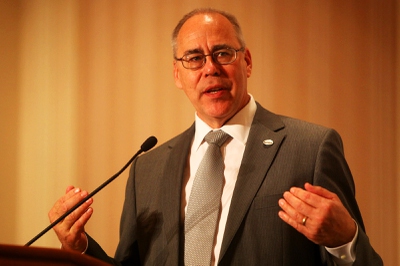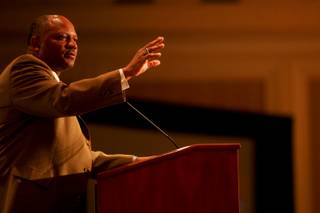
Clark County School District Superintendent Dwight Jones speaks during the 31st annual Las Vegas Perspective on Thursday, March 31, 2011, at the Four Seasons in Las Vegas.
Monday, April 4, 2011 | 2:01 a.m.
Sun Archives
- Tentative schools budget includes 2,500 layoffs, pay cuts, larger classes (3-25-2011)
- Students rally against education cuts, but what’s next? (3-22-2011)
- Higher ed switches from tales of budget woes to honesty (3-16-2011)
- School District seeks study on actual cost of educating students (3-14-2011)
- Hundreds urge lawmakers to battle proposed cuts to education (2-28-2011)
- Chancellor’s memo outlines scenarios involving closures, consolidations (2-25-2011)
Sun Coverage
UNLV President Neal Smatresk and Clark County Schools Superintendent Dwight Jones recently met on separate occasions with a top Strip casino executive. Smatresk delivered a gloomy picture of what could happen to the university if deep budget cuts are adopted by state legislators — the loss of classes, students, professors, grant dollars and a further blow to UNLV’s reputation.
Jones took a different approach.
Just entering his fourth month on the job, the former Colorado state education commissioner noted that these are tough times for the state and national economies. He acknowledged that budget cuts are coming, but then came a pivot: We will take a hit now, Jones said, but we must work together in the coming years to assess the performance of all aspects of the School District, implement change, and as the economy recovers restore the budget reductions to build a stronger district.
That was the message the casino executive wanted to hear.
“Dwight is right. This is an opportunity,” a second executive who attended both closed-door meetings said. Neither executive wished to be identified for this story. “You can’t argue gloom and doom. People don’t want to hear it right now, not when hundreds of thousands remain out of work or have had their hours cut.”
Smatresk and Jones are viewed as thoughtful, articulate advocates for their institutions. Neither is seen as shrill or prone to the hyperbole of Jim Rogers, the former chancellor of the Nevada System of Higher Education. Both are gentle, disarming men in body language and speech. Yet, the Strip executive viewed Smatresk’s messaging as too much negativity.
During a late-January town-hall meeting with UNLV students and faculty, Smatresk said: “Our future is at stake. The future of our state is at stake. The future of the good students who are here is at stake. If you are concerned about the economic future of our state, then you have to be concerned about UNLV.”
In a March 8 letter to faculty and students at UNLV’s Boyd Law School, Smatresk wrote of likely tuition increases to counter lost revenue from budget cutting: “These additional increases will undermine the law school’s successful formula and render it a mediocre institution.”
He’s also been quoted as saying “we’ve already squeezed the blood from the stone. This is horrific to talk about people like this.”
The Strip boss counseled Smatresk that UNLV should endure the pain during the current legislative session, then he should reach out for a communitywide commitment to rebuild the university during upcoming sessions.
“Neal heard the message, and he’s seemed to have softened his approach,” the second executive said.
Corporate executives and education reform advocates want to hear talk of academic, spending and administrative reform by the university and School District. They do not want the debate to be purely focused on the spending side of the equation. To be certain, Smatresk and Jones come from different places in the debate.
Smatresk has been at UNLV for four years, first serving as its No. 2 administrator, the provost, before replacing David Ashley as president in August 2009. His message is geared to multiple constituencies — professors, students, state legislators, the Nevada Board of Regents and taxpayers. He is viewed as being “of” the UNLV culture.
Jones also must reach lawmakers, the business community, neighborhood groups and taxpayers as well as School District employees and the parents of 310,000 students, but he is “the new guy,” and some businesspeople are willing to give him time to learn as he delves into the workings of the 28,000-employee School District.
“I don’t think any of those constituencies are looking to him to immediately have those answers when he’s still trying to get his arms around the system,” MGM Resorts International Senior Vice President Alan Feldman said. “That said, it would be our view that the path to consensus on how to properly fund education has to include serious discussion of reform. Simply finding ways to fund the status quo is unacceptable.”
The financial reality is troubling for UNLV and the School District. A projected 315 faculty and staff positions could be lost at the university if Gov. Brian Sandoval’s proposed budget is passed, according to Smatresk. If the cuts are made, the university would have lost more than 800 positions in recent years. Significant grant dollars would be reduced or eliminated. First-rate students would not get the classes they need.
The Jones and Smatresk styles were displayed Thursday at the Four Seasons at Mandalay Bay, where political, business and community leaders attended the annual Las Vegas Perspective breakfast. Jeremy Aguero of Applied Analysis laid out his statistical portrayal of economic reality in this region. Jones and Smatresk spoke separately to open the event.
Jones delivered a message of contrition and humility. Smatresk, a gentle sales pitch with a touch of frustration. Gone were some of the more strident statements that characterized his comments just a month ago.
“I would submit to you we’re a critical investment,” Smatresk said.
He spoke of the $250 million a year that is generated by Thomas & Mack Center. He pointed to $140 million spent annually by out-of-state students who he said have an annual economic effect of $240 million via a multiplier effect. UNLV brings in $100 million annually through grants and contracts that turn over four times through the regional economy, Smatresk added.
Overall, the university has graduated 100,000 students since opening in 1957, with 70,000 of them living and working in the region. Southern Nevada has one of the lowest percentages in the country for residents with bachelor’s degrees: 20 percent compared with the 40 percent who live in the Salt Lake City area.
“Part of our mission is to change that number so it’s closer to the regional competition,” he said. “That’s our mission. That’s our job.”
The tone was soft with little inflection. Jones was equally gentle, though his delivery was energized and disarmingly contrite.
“What I’m hearing from the community is that you don’t trust the data coming out of the school system,” Jones told the 450 people who attended the breakfast. “We will be transparent. You will be able to compare schools.”
He has brought in consultants to parse perceptions of the oft-criticized School District, which has a high school graduation rate of 48 percent to 72 percent, depending upon who’s offering the numbers. Johns Hopkins University produced the lower figure, the School District, the higher. Jones has made it clear to his staff that he wants the answer, the accurate answer.
The district stands to lose $250 million to $400 million from its budget, depending on the outcome of the legislative session in Carson City, and that could mean the loss of 2,486 jobs, according to a worst-case scenario.
Jones is seeking numbers that would speak to the district’s “true effectiveness” in a variety of areas, from all levels of student education to teacher and administrator performance. He is a process guy, and he is not prepared to talk dismally until he has a fuller understanding of the district, for now.



Join the Discussion:
Check this out for a full explanation of our conversion to the LiveFyre commenting system and instructions on how to sign up for an account.
Full comments policy